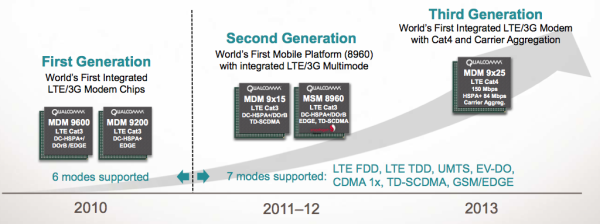Preparing for the iPhone Next: Rumors Analyzed
by Brian Klug & Anand Lal Shimpi on August 27, 2012 9:40 PM EST- Posted in
- Smartphones
- Apple
- Mobile
- iPhone
Cellular Connectivity: LTE Expected
The iPhone has always used separate applications and baseband processors. The next model is not expected to be any different. The big addition with the upcoming iPhone will be a massive and much needed improvement in cellular connectivity. Put simply, the addition of both support for LTE in the Americas and perhaps a few other international markets, and TD-SCDMA support for China. Support for LTE is simply requisite for a high end smartphone at this point, and inclusion of TD-SCDMA is likewise requisite for any further growth in China.
The commercial availability of Qualcomm's second generation Gobi modems and transceivers will make this possible without the design caveats posed by the previous generation of LTE basebands. Specifically, caveats such the lack of a built in codec for voice, requiring the so-called Qualcomm SoC fusion scenario that required MDM9x00 to ship in conjunction with a Qualcomm SoC to enable voice (whereas MDM9x15 is natively voice enabled). That's to say nothing of power draw which improved over time for MDM9x00 with software improvements (such as inclusion of more DRX features), but still precluded inclusion in an iPhone without a battery penalty. There's a reason you see MDM9x00 in the iPad 3 with WiFi but not in the iPhone 4S, even though it was available for that product's release.
The part we've fingered for baseband in the next iPhone is Qualcomm's MDM9x15 platform, which is a 28nm TSMC device that includes support for Category 3 LTE TDD and FDD, up to Release 8 42 Mbps DC-HSPA+, GSM/EDGE, TD-SCDMA, and CDMA2000 1x, 1xAdvanced, and EVDO on the MDM9615 variant. This is the same IP block as what is already inside shipping MSM8960 SoCs and devices today, where we've seen great battery life and LTE performance. There's one further improvement as well which MDM9615 hopefully will have over the current MSM8960 implementation, and that's the inclusion of a new 28nm RF (as opposed to logic) transceiver named WTR1605, instead of the 65nm RTR8600. This new transceiver also includes even more ports (7 instead of 5 on RTR8600) which means we will see likely more 3G or 4G LTE bands supported in this upcoming device. Even without that improvement we'll see inclusion of LTE without any caveats.
Because 2x2 MIMO is mandatory for LTE Category 2 and above (and 2 receive diversity mandatory for all LTE categories), you can see how that top bottom RF window and antenna split we touched on earlier makes even more sense. Again, this isn't a big leap from the iPhone 4S which already features both receive and transmit diversity split between top and bottom antennas, but just further fits into the LTE iPhone puzzle.
A small note under the cellular category is that this will also likely continue to be where GNSS (GPS and GLONASS) resides, something the CDMA iPhone 4 and 4S both already have courtesy the MDM66x0 baseband inside. MDM9x15 bumps this slightly, from Qualcomm's GPSone with GLONASS generation 8 to 8A, though I'm not certain what all improvements come from that change in version.












131 Comments
View All Comments
alxx - Tuesday, August 28, 2012 - link
or buy it to replace iphone 4 with starting to fade batteriesplext0r - Tuesday, August 28, 2012 - link
That's my dilemma. IPhone "Next" or SGS3. :) I currently have the iPhone 4.ltcommanderdata - Tuesday, August 28, 2012 - link
Hopefully Apple adopts a wide gamut IPS screen for the next gen iPhone as they've done for the 2012 iPad.It's too bad Apple's Q3 iPhone release schedule leaves them at an awkward time at the tail end of this silicon generation. Sticking to a 32nm A5, a 50% clock speed bump over the iPhone 4S to 1.2GHz seems reasonable and would be well positioned at launch. However, competition will come very quickly with Cortex A15 based CPUs and OpenGL ES 3.0 capable GPUs in Q4 and Q1 2013.
alxx - Tuesday, August 28, 2012 - link
In A15 chips are up to speed and ready in time.Has any A15 based chip been public-ally demoed over 1GHz yet ?
leomax999 - Tuesday, August 28, 2012 - link
Exynos 5250 in disguise at SIGGRAPH.krumme - Tuesday, August 28, 2012 - link
Iphone buyers dont buy specsExcept when Apple tells them to do
Therefore Apple can be as conservative and innovative as is needed in the market situation. No other company have that luxury.
Tegeril - Tuesday, August 28, 2012 - link
Sigh.doobydoo - Thursday, September 6, 2012 - link
The only reason iPhone buyers don't buy specs is that specs have never been an issue for iPhone users.That is to say, the software and apps have always run flawlessly on iOS.
The same can't be said for Android.
As for why this is the case? Look no further than the tight integration between hardware and software combined with, for example, the fact that the iPhone 4S has the fastest GPU in any smartphone in America.
rupaniii - Tuesday, August 28, 2012 - link
I'm guessing Power teaked version of the A15 core in Dual configuration, along with the top of the line PowerVR in Dual GPU configuration. It's got to be a world beater. Definitely worldwide LTE locked at carrier level.If not, Snapdragon S4Pro will own it.
A5 - Tuesday, August 28, 2012 - link
None of those designs (A15 or PowerVR 6-series) are ready yet. Apple has never been one to fight the spec war, and I don't see any of that changing now.